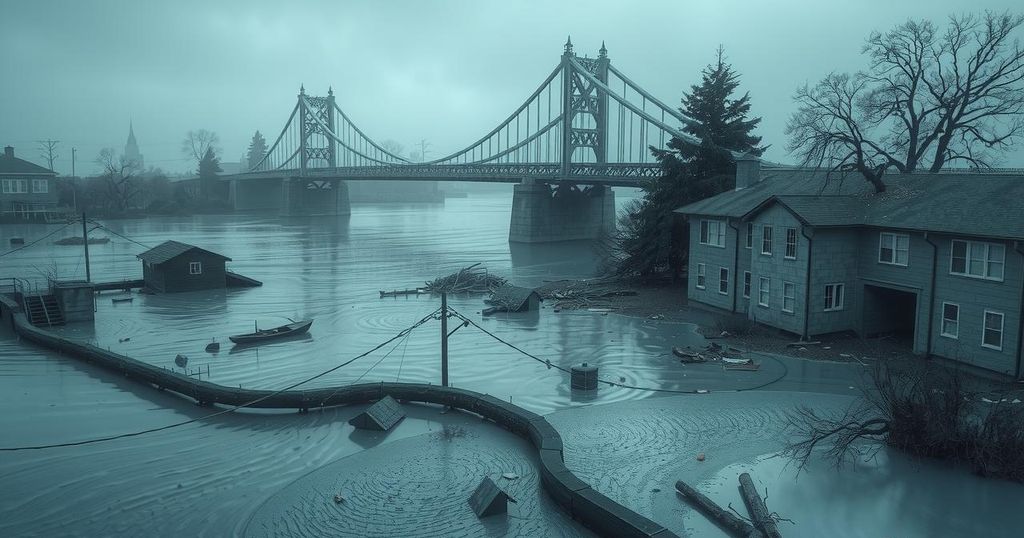President Ramaphosa Visits Flood Sites as Death Toll Reaches 78 in South Africa

South Africa’s President Cyril Ramaphosa visited flood-hit areas where the death toll is at 78 and expected to rise. His trip sought to address the response to the devastating floods that struck the Eastern Cape province. Rescue efforts face criticism over inadequate resources and the impact on vulnerable communities.
CAPE TOWN, South Africa — President Cyril Ramaphosa visited areas affected by catastrophic flooding in the southeast, where the death toll has now reached at least 78, and could likely increase. This trip to Mthatha in Eastern Cape province marks his engagement as search efforts enter their fourth day amidst fears of additional casualties.
The floods started early Tuesday, hitting hardest in Mthatha. Ramaphosa attended a briefing with officials from the National Disaster Management Center and surveyed a bridge where a school bus was swept away. Tragically, six students, the bus driver, and another adult were confirmed dead, with four more children still unaccounted for.
Criticism is growing over the response to this disaster, triggered by a severe weather front that brought heavy rain and strong winds to the area. Concerns stem from warnings issued last week, indicating that authorities were not sufficiently prepared.
Oscar Mabuyane, the Eastern Cape Premier, expressed frustration regarding the state of rescue operations, stating they were “paralyzed” in the initial hours due to a lack of vital resources including proper teams, divers, and K-9 units. The struggling province, which has a population of about 7.2 million, only has one rescue helicopter available, and it had to be sourced from over 500 kilometers (310 miles) away.
Ramaphosa defended the government’s actions, asserting that while the current situation is horrific, “it could have been much worse.” Many victims were caught off guard by the floods, leading to devastating outcomes as they were swept away along with remnants of their homes. Fortunately, the rain has ceased, and floodwaters are beginning to recede.
Rescue teams are continuing their search through the waters and remnants of damaged infrastructure, expecting to recover more bodies as conditions improve. Zinathi Vuso, a resident of Mthatha, shared harrowing memories, stating, “I need psychological help because I saw people dying in front of me. They were being dragged by the water along with the corrugated iron. ”
As the search continues, bodies have reportedly been located two kilometers away from where they were believed to have been during the incident. Emergency response teams are urging residents to report any missing individuals, providing vital information for more efficient searches. Velenkosini Hlabisa, the Minister for Cooperative Governance and Traditional Affairs, commented on the crisis, saying, “We are in a crisis. A real disaster. The more water subsides, the more people will be found.”
Parts of South Africa’s coast are increasingly susceptible to severe weather events originating from the Indian and Southern Oceans. The country has experienced prior tragedies, with over 400 fatalities reported during the 2022 floods in the Durban area. The most vulnerable communities, especially those situated on flood plains, have suffered the most during this recent disaster.
While conditions are improving, the effects of the flooding will be felt for a long time, particularly in the poorest regions where informal housing was severely affected.
AP Africa news: https://apnews.com/hub/africa
In summary, the recent floods in South Africa’s Eastern Cape province have led to at least 78 confirmed deaths, with the potential for more as rescue efforts continue. President Cyril Ramaphosa’s visit underscored the challenges faced by local authorities in managing the crisis. Criticism regarding the inadequate emergency resources surfaced, reflecting a broader issue of vulnerability in poorer communities. As the situation stabilizes, the acknowledgment of ongoing risks amid extreme weather remains crucial.
Original Source: www.wral.com







